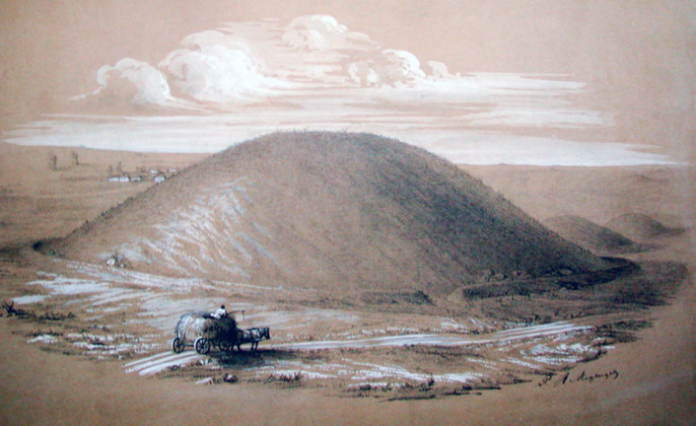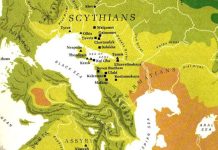A century ago, British academic Dr. E. Minns concluded that the finest of the Scythian kurgans were “about the bend of the Dnépr, near Alexandropol, near where we should put the land of Gerrhus”. It was in that area that the class of “the so-called Big Barrows” was situated and the chief of those were the Alexandropol Kurgan (also called the Meadow Barrow/ Lugova Mogila), and the Chertomlyk/ Nicopol Barrow. “Of the barrows about the Dnépr, those most remarkable for the variety of their contents are that near Alexandropol and that at Chertomlyk, twelve miles n.w. of Nicopol,” wrote the renowned archaeologist. Alexandropol (24m) was the tallest of the four Scythian royal kurgans located in the northern Black Sea area; next was Oguz (20m), Chertomlyk (19m), and Solokha (18m). The Alexandropol kurgan became the first Scythian royal kurgan that was excavated specifically for research purposes in the middle of the 19th century. In 1854–55, the mound of the kurgan, unlike those of the rest of the kurgans, was completely unearthed in a very thorough manner. The credit for the excellent for that time archaeological work should be given to A.E. Liutsenko who also studied the numerous subterranean structures of it. Although the central burial had been plundered, hundreds of objects of gold, silver, bronze, iron, leather, and bone, as well as pottery were found in the earthen mound itself, in the shafts, tunnels, and chambers underground. One burial near the central chamber that also presumably belonged to the king was discovered, turned out to be very rich in artifacts. Dating to ca. 320 B.C., Alexandropol kurgan is considered the latest among the kurgans of the highest Scythian aristocracy in the northern Black Sea territory.

In 2003, The Institute of Archaeology of the National Academy of Sciences of Ukraine (Kyiv) and the Florida State University (Tallahassee) signed an agreement on joint exploration and research of Scythian burial mounds (kurgans). In 2004–05, the American-Ukrainian Scythian Kurgan Project (AUSKP) conducted geophysical surveys and excavations at and near the Alexandropol kurgan. Shortly afterward, a Report was published coauthored by a Professor of Classics and Distinguished Research Professor at Florida State University Dr. N.T. De Grummond. According to it, the expedition managed to locate the ditch and the external earth rampart that once surrounded the kurgan, which were mentioned in the 19th-century descriptions but did not provide dimensions. The ditch was discovered, measuring 4.0–4.5 m in width, 2.0–2.5 m deep into the ground with the diameter of it being close to 110 m. The 2004-2005 expedition was the first to discover the area where the tremendous funeral feast was held after the completion of the mound – it was held in the “vicinity of the western path across the ditch and the rampart of the kurgan”, and reached far out beyond the limits of the mound into the surrounding field. “The Alexandropol kurgan may become the first where it will be possible to explore the complete content of the Scythian royal funeral feast to its full capacity” – wrote the scholar. < Who Was Buried in Alexandropol Kurgan Most Famous Artifacts >










